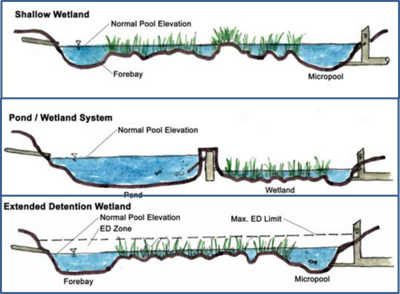
Types of stormwater wetlands Revision as of 14:09, 31 December 2012 by Chochstein (talk | contribs)
Revision as of 14:09, 31 December 2012 by Chochstein (talk | contribs)
Stormwater wetlands are constructed with varying amounts of the following three components:
- Shallow marsh area
- Permanent micropool area
- Storage volume above the normal water level
The amount of each of the components named above depends on the desired type of stormwater wetland (e.g., shallow wetland). Figure 12.WETL.1 shows the three major types of stormwater wetlands presented in this Manual.
Stormwater wetland design must be tailored to site characteristics; however, some general RECOMMENDED design criteria for shallow wetland, ED shallow wetland, and pond/wetland design are presented in [Table 12.WETL.1.]
The proportions of deep water, low marsh, high marsh, and semi-wet marsh are presented above in Table 12.WETL.1 and are defined as:
- Deepwater zone – From 1.5 to 6 feet deep. Includes the outlet micropool and the deepwater channels through the wetland facility. This zone supports little emergent wetland vegetation but may support submerged or floating vegetation. It is consistent with the Cowardin Wetland Classification of palustrine aquatic beds.
- Low marsh zone – From 6 to 18 inches below the normal permanent pool or water surface elevation. This zone is suitable for the growing of several emergent wetland plant species.
- High marsh zone – From 6 inches below the pool to the normal pool elevation. This zone will support a greater density and diversity of wetland species than the low marsh zone. The high marsh zone should have a higher surface area to volume ratio than the low marsh zone.
- Semi-wet zone – Those areas above the permanent pool that are inundated during larger storm events. This zone supports a number of species that can survive flooding.
